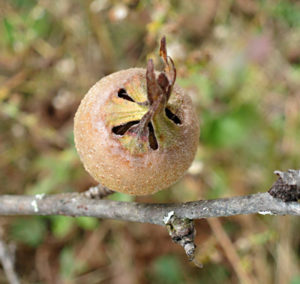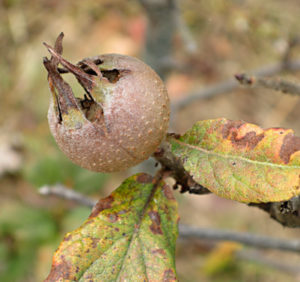 |
| Medlars. Photos by Will Bonsall. |
 |
By Will Bonsall
When I speak of medlars, people are apt to assume that I’m referring to folks who stick their noses into other folks’ business, but in this case I’m talking about a little-known and less-grown fruit. Despite its botanical name, Mespilus germanica, and its long cultivation in northern Europe, the plant actually originated in southwestern Asia, especially the Black Sea coast of Turkey.
It is a typical pome, with an apple-like core containing five or more hard seeds, each about the size of a large corn kernel. With large and persistent sepals, it reminds me of a rosehip crossed with a crab apple. Something about the opening at the blossom end gives it a decidedly banal look, which is referenced in several common names. In Shakespeare’s day it was called the cat’s-arse fruit, and the French know it as cul-de-chien, or dog-butt. If these names aren’t off-putting enough, its color – sort of a dull greenish-brown ripening to a yellowish-rusty-brown – does little to redeem it.
If you get past all that, a taste of the freshly picked fruit will put you off forever. But then, you’re not supposed to eat it fresh from the bush (or small tree); like persimmon, the medlar needs a long after-ripening process to render it palatable. Spread fruits one layer deep in a cool, dry place for a few weeks, and they become soft and … well, you’re not supposed to call it “rotten” (any more than Jello-like persimmons), but “bletted” is the accepted word, which seems to have been coined from a French word in reference to only this particular fruit.
So what exactly does this wry-bespoken fruit have going for it? It is quite easy to grow, taking little space and bearing young. The flowers are lovely, and pests are no problem. Pruning is minimal and hardiness is sure. But so what, if it’s not tasty?
Indeed it is quite tasty when properly rotten … er, bletted. One of its favored features is that it can be kept into winter when most other fresh fruits are unavailable. Of course that was more important in the Middle Ages, when the markets weren’t full of fresh grapes from Chile in January.
A lot (well, compared to a few) of rare-fruit aficionados fancy bletted medlars as a gourmet delicacy, valued for their nuanced je-ne-sais-quoi ambience. (You try describing these things with all-English words!) They use words like “smoky,” “earthy” and “musky.” For better or worse, I never picked up on any of those flavors. One comparison to baked spiced applesauce is much closer to my experience.
Two suggested ways of using medlars are as jelly and as a sort of pudding with beaten eggs and butter. Neither appeals to me. With enough pectin, lemon juice and added sugar, you can make jelly out of windshield wiper fluid. I prefer foods, including the “additives,” that come from my own land. Nor am I excited about the pudding-y stuff; I never eat anything that comes out of a bird’s private parts (but if you do, there are recipes online).
Some people suggest puncturing the fruit and sucking or spooning out the ripe flesh. That’s fine, but you still have to contend with the seeds, which is a minor chore but limits how many you’ll bother to eat.
This year I harvested a half-peck of rock-hard fruit from three bushes (but mostly from one) and I kept (bletted) them until late December, when I mashed them whole and uncooked and pureed them through a strainer. (The hand-crank ricer was barely effective.) Although the interiors were off-white and very firm when harvested, after bletting they became soft and creamy, and a rusty brown color. The pureed pulp was like a thick applesauce. And the flavor? I found it quite pleasant but not as exciting as gourmets described. I still have a pint of raw purée in the fridge, and I shall try cooking it to see if I get something more evocative.
I have to suppose that the results might have been more soul-thrilling if I had not held the fruit in storage for quite so long before mashing and eating them. Sources suggest harvesting in October (mine were harvested in November, still in fine shape) and storing/bletting them for two to three weeks (mine were at least six weeks). In other words, I may have overdone it (I always say, moderation is a good thing if you don’t carry it too far), and the flesh, while certainly not rotten, may have lost some of its redolent flavor over time, as apples do.
The yield from a single fruit is not particularly impressive, but the production of fruit per bush was respectable, and that’s in its third year. Moreover, medlars bear consistently, even after severe winters and late spring freezes that wipe out other fruits. They are supposedly self-fertile, which is important for those with limited space. I know this is so, because the first year, when I had only one bush flowering, I still got several fruits. I do think they are well worth the bother, and I look forward to a larger crop this year so that I can experiment further with them.
If you’re inspired to experiment with this rare and exotic fruit, medlar plants are not found in just any and every nursery catalog (see Sources); however, you can graft your own, if you have a source of scionwood and rootstocks. I can provide a limited amount of scionwood, or you can order some from USDA’s National Clonal Germplasm Repository in Corvallis, Oregon (www.ars.usda.gov/main/site_main.htm?modecode=53-58-15-00), which maintains at least a score of varieties, including ‘Nottingham’ and ‘Breda Giant’.
They can be propagated by simple cleft-grafting, but what to graft onto? Other medlars, of course, but lacking those you can supposedly use apple and quince. That’s hearsay; I use wild hawthorns, which grow in a corner of my hayfield. Medlars will “take” nicely on them, but as with many interspecific grafts, they may become incompatible over time and reject each other. My solution to that is “nurse grafting.” I cleft graft rather low on the haw rootstock; if that takes well, the following spring I dig it all up and replant it where I want it to stand, only in a deeper hole, so that when I fill the planting hole, the graft union is below grade. If at some point the rootstock and scion fail to hit it off well together, the medlar may by that time have rooted on its own (called “scion-rooted”) and become independent of the haw.
Medlars grow up to 15 to 20 feet tall, and to my knowledge no wildlife bothers them, but then of course, wildlife species probably haven’t learned the secret of bletting.
Of course any fruit is improved by breeding and selection, and very little of that has been done with the medlar, as is apparent from the small number of cultivars known to exist. I’m interested in following up on that idea, so I’ve saved all my unheated seed this year and stored it in a place that is protected from rodents (not from cold, which medlar seeds need to break dormancy and germinate). I intend to sow the seed this spring and see what I get, which may mean tying up a lot of space for plants that could well have inferior fruit. Some, on the other hand, may be superior to either parent – assuming they are from cross-pollinated flowers, but even selfed seed will produce much more variation than the original clone. At the very least, I’ll have an expanded population of rootstocks upon which to graft more of the known varieties. Anyone caring to participate in this experiment should get in touch with me.
Sources
Raintree Nursery, 391 Butts Rd., Morton, WA 98356; www.raintreenursery.com
Burnt Ridge Nursery, 432 Burnt Ridge Rd., Onalaska, WA 98570; www.burntridgenursery.com
Aaron’s Farm Nursery, POB 800, Sumner, GA 31789; www.aaronsfarm.com
About the author: Will Bonsall lives in Industry, Maine, where he directs Scatterseed Project, a seed saving enterprise. He is writing a book called Gardens Without Borders, to be published by Chelsea Green. You can contact him at [email protected].
